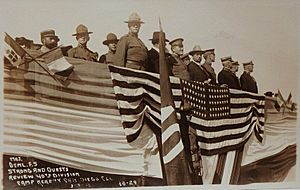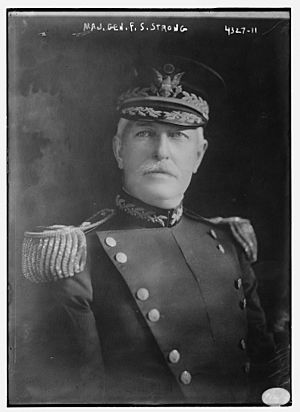Frederick S. Strong facts for kids
Quick facts for kids
Frederick S. Strong
|
|
|---|---|

Strong as commander of the 40th Division in 1918
|
|
| Born | November 12, 1855 Paw Paw, Michigan |
| Died | March 9, 1935 (aged 79) San Diego, California |
| Buried | |
| Allegiance | United States |
| Service/ |
United States Army |
| Years of service | 1880–1919 |
| Rank | Major General |
| Unit | U.S. Army Field Artillery Branch U.S. Army Coast Artillery Corps |
| Commands held | Michigan Military Academy Coast Defenses of Eastern New York U.S. Army Coast Artillery School Coast Defenses of Chesapeake Bay South Atlantic Coast Artillery District Schofield Barracks Hawaiian Department 40th Division Camp Jackson Camp Kearny South Pacific Coast Artillery District |
| Battles/wars | American Indian Wars Spanish–American War World War I |
| Spouse(s) | Alice Marion Johnson (m. 1883–1935, his death) |
| Children | 1 |
Frederick S. Strong (born November 12, 1855 – died March 9, 1935) was an important officer in the United States Army. He became a Major General. He fought in the American Indian Wars, the Spanish–American War, and World War I.
Strong was well-known for leading the Hawaiian Department from 1916 to 1917. He also commanded the 40th Division during World War I.
He was born in Paw Paw, Michigan. Strong finished Kalamazoo High School in 1876. He then graduated from the United States Military Academy (West Point) in 1880. He started as a second lieutenant in the 4th Field Artillery Regiment.
Strong taught at West Point and the Michigan Military Academy. He also served in artillery units across the western United States. During the Spanish–American War, he worked as an assistant adjutant.
After the war, Strong led the Michigan Military Academy. He also served in the Philippines. He later commanded several important military areas, including the Coast Defenses of Eastern New York. He also led the Coast Artillery School. Before World War I, he commanded the South Atlantic Coast Artillery District and the Hawaiian Department.
During World War I, Strong led the 40th Division in France. This division provided replacement soldiers to other units fighting in the war. After the war, he commanded Camp Jackson and Camp Kearny.
Strong retired in August 1919 and lived in San Diego. He passed away on March 9, 1935, and was buried at Arlington National Cemetery.
Contents
Early Life and Military Training
Frederick Smith Strong was born in Paw Paw, Michigan, on November 12, 1855. His parents were Samuel Filer Strong and Anna Maria Fish. He finished Kalamazoo High School in 1876.
After high school, he went to the United States Military Academy. He graduated in 1880, ranking 11th in his class of 51 students. He became a second lieutenant in the 4th Field Artillery Regiment.
After graduating, Strong stayed at West Point for a few months. He worked as an assistant instructor. In December 1880, he joined his regiment in California. He served at Fort Point and Fort Alcatraz. He later moved to Fort Canby in Washington state and Fort Stevens, Oregon. In October 1881, he transferred to Madison Barracks in New York.
Developing His Military Career
In April 1882, Strong went to Fort Monroe, Virginia. He attended the Artillery School. He finished his training in April 1884. After that, he became a professor of military science and tactics at Michigan Military Academy. He stayed there until September 1888.
In September 1887, he was promoted to first lieutenant. After some time off, he was sent to Fort McPherson, Georgia, in July 1889. He then moved to Fort Riley, Kansas, in September 1889.
While at Fort Riley, Strong served with the 4th Field Artillery. He took part in a campaign during the American Indian Wars from 1890 to 1891. He commanded an artillery unit that worked with the 1st Cavalry Regiment. From 1891 to 1892, Strong was again at Fort McPherson. He then returned to Michigan Military Academy for a second time. He taught there until September 1895. From October 1895 to May 1898, Strong was the adjutant for the 4th Field Artillery at Washington Barracks in Washington, D.C..
Serving in Key Commands
In May 1898, Strong was promoted to temporary major during the Spanish–American War. He served as assistant adjutant for the 1st Division. He worked at Camp Mackenzie near Augusta, Georgia. He left the Volunteers on March 31, 1899. On March 2, 1899, he became a permanent captain.
From 1899 to 1902, Strong was stationed at Fort Monroe. He worked as adjutant for the 4th Artillery and the Artillery School. From 1902 to 1904, Strong was the superintendent of Michigan Military Academy. He then worked as an inspector general for the Field Artillery. He was promoted to major in November 1904.
Strong became a lieutenant colonel in the Coast Artillery in July 1907. He served in the Department of the Lakes until May 1909. From May 1909 to March 1911, Strong was in the Philippines. He was the adjutant for the Department of Luzon.
He was promoted to colonel in March 1911. He was assigned to Fort Totten, New York. There, he commanded the Coast Defenses of Eastern New York. In August 1911, he was given command of the Coast Artillery School. He also commanded the Coast Defenses of Chesapeake Bay.
From September 1911 to November 1915, Strong was in Charleston, South Carolina. He commanded the South Atlantic Coast Artillery District. He became a brigadier general in May 1915. From December 1915 to November 1916, Strong commanded Schofield Barracks in Hawaii. He then led the Hawaiian Department from November 1916 to July 1917.
World War I Service
In August 1917, Strong was promoted to temporary major general. He was given command of the 40th Division. He oversaw its organization and training at Camp Kearny, California.
When the division arrived in France in August 1918, the War Department decided to use new divisions differently. They would provide replacement soldiers for units already fighting. Strong commanded the 40th Division as a depot division. It was based in Revigny-sur-Ornain.
After the war ended in November 1918, Strong remained in command. The division moved to Castres-Gironde and waited to return to the United States. The 40th Division arrived in the U.S. on March 3, 1919. It then went to Camp Kearny, where it was disbanded on April 20, 1919.
After World War I and Retirement
After returning to the United States, Strong commanded Camp Jackson, South Carolina. This was from March to April 1919. He then commanded Camp Kearny from April to July 1919. In June, he returned to his permanent rank of brigadier general. From July to August 1919, Strong commanded the South Pacific Coast Artillery District.
Strong was set to reach the mandatory retirement age of 64 in November 1919. In August 1919, he asked for early retirement, which was approved. He then settled in San Diego. In June 1930, a new law allowed World War I generals to retire at their highest rank. Strong was then advanced to major general on the retired list.
From 1933 to 1934, Strong served on California's Relief Commission. This group helped manage social welfare programs during the Great Depression. Strong passed away in San Diego on March 9, 1935. He is buried at Arlington National Cemetery with his wife, Alice.
Legacy and Family
Battery Strong, a Coast Artillery firing position, was named after Frederick S. Strong. It was located at Fort Rosecrans, California. It was used from 1937 until 1946. Today, the site is part of the Naval Supply Center San Diego Annex. Some parts of the battery still remain, but the area is not open to the public.
In 1883, Strong married Alice Marion Johnson (1863–1936). They had one son, Frederick William Strong Jr. (1887–1986). Their son also graduated first in his class from West Point in 1910. He served in the Army before starting a business career in Detroit. He also became a brigadier general before retiring from the military in 1946.



